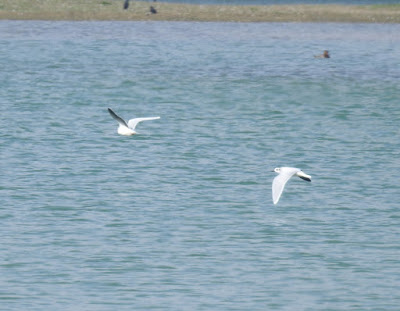After a good end to March, the year ticks continued in early April. The first Wheatear just missed March and appeared at Pump Lane on April 1st:
This was followed on April 2nd by a pair of Peregrines circling over the lake. I couldn't see if they were adult or not, but I do wonder where these came from.
There then followed a period of over 2 weeks when nothing new turned up, which wasn't helped by and was probably the result of the weather patterns. Another Wheatear appeared on the spit for the day on the 12th, a nice male, but with only two records of Wheatear this month, a really poor showing for this species so far.
 |
| Distant crop! |
The last Redwing of the season was a bird foraging in Pump Lane fields on the 14th.
My next year tick was Reed Warbler on the 17th, with two singing birds arriving. The same morning produced a partial summer plumaged Dunlin that flew in mid morning and landed on the far side of the spit so evading photographs.
The 18th had an obvious movement of Arctic Terns in the area. There were none on site first thing, but as I watched, one appeared mid morning with the Common Terns. Common Tern numbers also rose to 17 that day, having been climbing steadily in 1s and 2s over the previous fortnight. The Arctic Tern spent most of its time, as usual, flying over the eastern side of the lake, but later in the day, it did land on the spit a couple of times.
The 18th also saw the arrival of two singing Sedge Warblers and were new for the year. Again, this species doesn't breed on site, so they all move through in the Spring.
Other expected migrants appeared over the next week, with the first singing Whitethroat being heard along the railway on the 19th, the first Common Sandpipers, two birds, arriving on the 22nd on the same day as Garden Warbler. There were three Garden Warblers singing by the 24th. Swifts were a little late this year, with my first birds, in fact 18, on the 24th. The 25th produced my first Yellow Wagtail, when a calling bird flew over the lake mid morning.
Waders have been poor so far, with the obvious notable exception of the pair of Black-winged Stilts (see previous post). Little Ringed Plovers have arrived in numbers though and six birds have been present for a while, while Oystercatchers fluctuate between a pair and three birds.
One surprising occurrence was the possible reappearance (or a new bird) of the female Black Swan that disappeared during the freezing weather in January. This bird was pinioned, but I'm not sure if the new bird is or not. If it is the old bird, which seems likely, where did it go for three months? Was it 'rescued' from the ice and then released?
I've also added a shot of the feral Barnacle goose that appears to be paired with a Graylag and has ben flying into the site occasionally. And look at the brood size of this Mallard, 16 ducklings!
And to end, some shots of a Weasel that appeared below my feet as I was photographing the Arctic Tern. This joins Stoat that I saw in March onto my patch mammal list. Also, the pair of cavorting foxes that often come out and try and disturb the birds - they certainly stop any breeding on the spit and are often seen carrying goose eggs.








































